In this post, I’ll describe my experiences on a recently concluded 6 day, 5 night rafting trip down the Colorado river in the Grand Canyon National Park with Western River Expeditions. I just got back from the trip and the 6 days spent on the river were one of the most unique and memorable in my life. Along with about 15 other people and 3 crew members, I traveled ~180 miles down the Colorado river from Lees ferry to the Whitmore helipad (near mile 187, see map below) on a J-rig raft and saw the Colorado river carve its way down the canyon exposing layer after layer of ancient rock, each rock layer telling another chapter in the billion+ history of the canyon. Along this journey, I encountered world-class white water, said hello to many deer, bighorn sheep and flocks of birds, saw Anasazi symbols, camped on sandy campsites and slept under the stars and enjoyed the company of several nice people with fascinating life stories.
It all started a bit more than two weeks ago when my friend Michael (who lives in San Francisco) called. Mike, like me and many others holed up in their homes because of the pandemic, wanted to get out for a few days. One of his acquaintances Zenia (who ended up on the same trip with us) had mentioned the Rafting expedition on the Colorado river. The timing was perfect – my work schedule for the next couple of weeks was relatively light and I had been toying with an end-of-summer trip. We took a quick look at the trip details, itinerary, customer reviews and such and decided to do the trip right away. Normally, these rafting trips are booked up one and sometimes two years in advance, but we were able to get a spot on a trip that scheduled for just a week and half later because of covid-19 related cancellations.
Trip itinerary
Our tour company, Western River Expeditions offers several destinations for rafting – rivers in the Grand Canyon, Utah, Oregan, Idaho and Costa Rica. For each destination, there are several trip variants depending on how much time you want to spend on the water and distance you want to cover. For the Grand Canyon, there are 4 choices – 3 or 4 day and the 6 or 7 day trips. The 3 and 4 day trips start and end at the same point on the river as the other. Likewise for 6 and 7 day trip. The longer version simply proceeds a bit slower, with more time available for excursions such as local hikes. The 3 and 4 day trips begin where the 6 or 7 day trips end. Thus, at the end of our trip, the helicopter that picked us up also delivered the passengers for the 3/4 day trip who boarded our raft and carried on another 100 miles down the river.
We booked the 6 day, 5 night package. The trips starts at Marble Canyon, Arizona. One can either meet the trip directly in Marble Canyon (as many locals do) or get flown in from Las Vegas on a small plane. Mike and I flew into Las Vegas the day before the start of our trip. This was my first time boarding a plane since the start of the Covid-19 pandemic, and I was a bit apprehensive. However, I was happy to see that my airlines (United) follow social distancing and mask wearing protocols as well as could be expected. Passengers on the flight and at the airports also wore masks and respected social distancing rules.
We stayed at a Marriott in Las Vegas. Western River, our tour company has an arrangement with Marriott so tour participants can get special booking rates. We had a pleasant evening in Las Vegas although the impact of Covid-19 on the visitor flow to Las Vegas was easy to see. The usual crowds of revelers around the strip were nowhere in sight.
Our trip started at around 5 AM the following morning (Aug 26). We boarded a bus that took us to the Boulder City Municipal Airport, a small regional airport (about a 40 min ride). From the airport, we boarded a small plane to Marble Canyon, a ~1.5 hour trip. Got some nice views of the Hoover dam along the way. We boarded our rafts at Lees Ferry, a few miles downstream of the Glen Canyon dam, and one of the few entry points into the Colorado river.
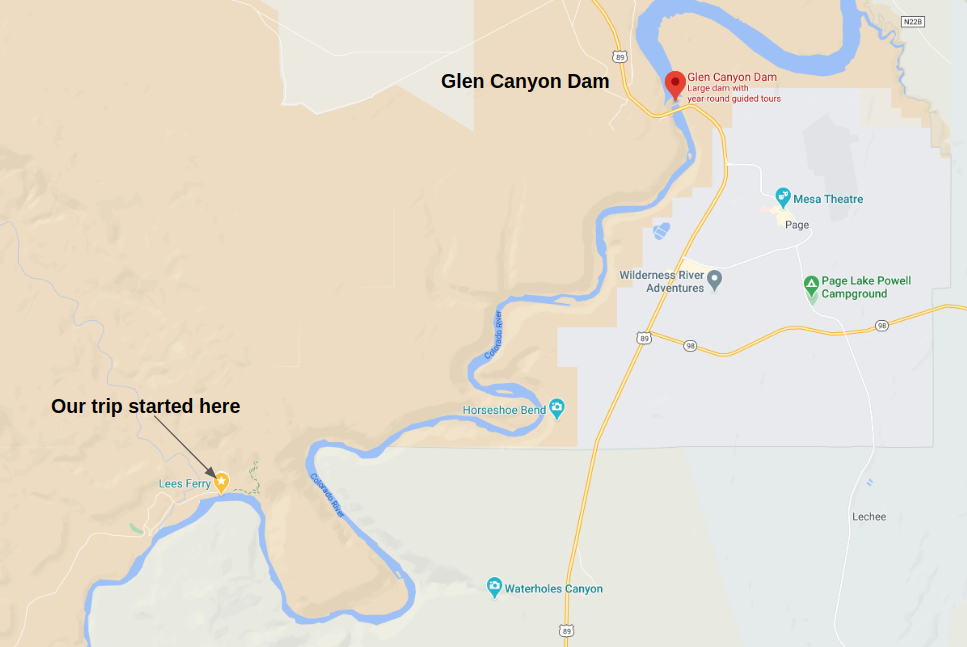
As we made our way down the river, we camped at the numerous campgrounds along the Colorado river, nestled between the steep walls of the Grand Canyon. Our trip ended at Whitmore Wash (around Mile 188) where we were picked up by a helicopter and dropped off at the Bar Ten ranch, about a 10 min helicopter ride away. From the ranch, we took another flight back to Boulder City Municipal Airport and a bus ride from the airport back to the Marriott in Las Vegas. The map below shows the trip itinerary, along with the places along the river where we set up camp.
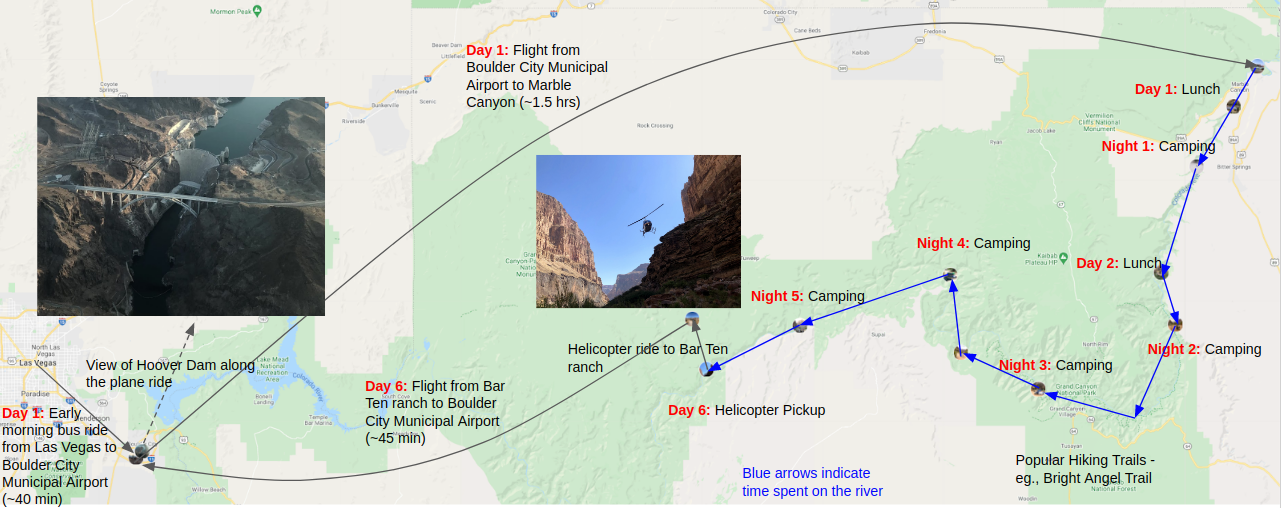
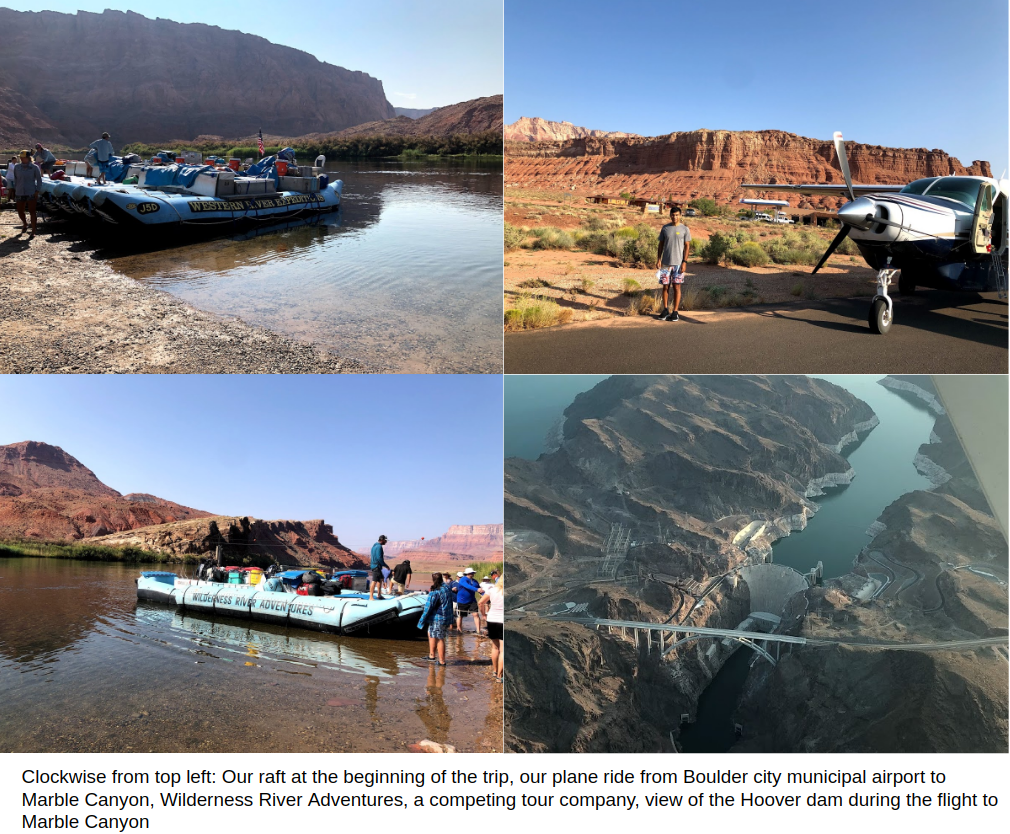
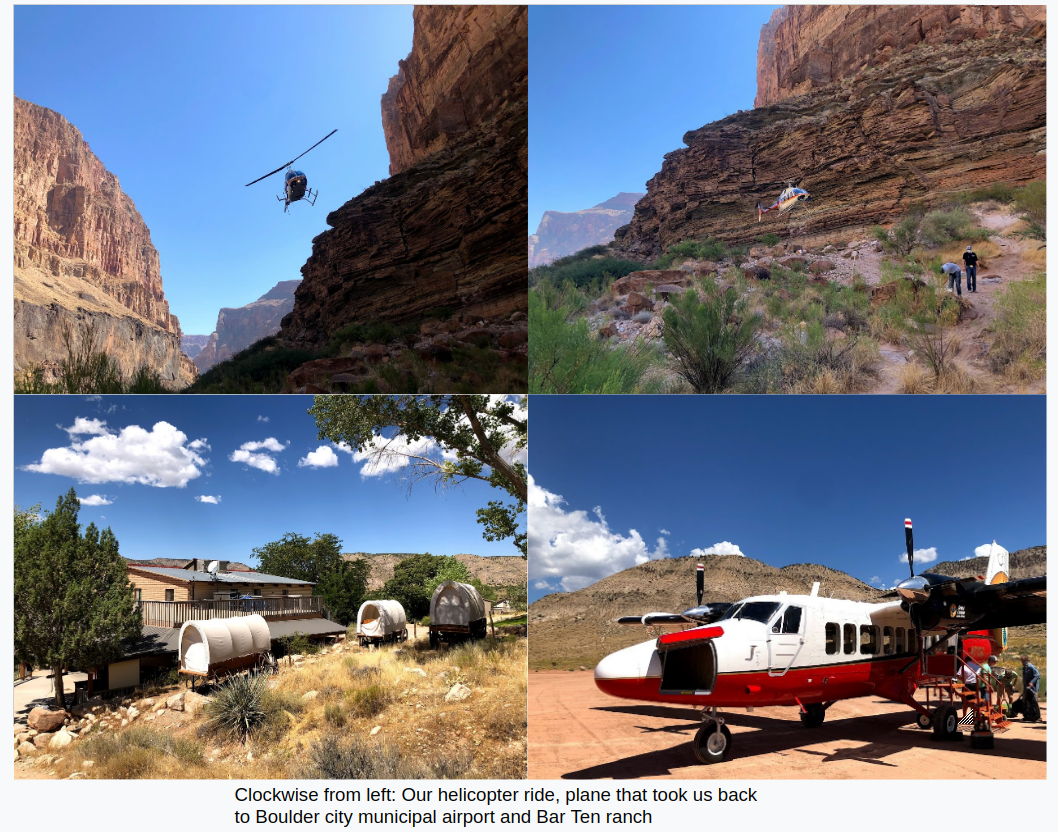
A quick aside. In addition to recording and sharing trip memories, another benefit of writing these blogs is that I often learn useful features of software applications I need along the way. Making the trip itinerary shown above took me about an hour and half. I was struggling with how to show the location of the places where we camped. I knew the names of the camp sites, however the names being obscure and rarely encountered, were not showing up on Google maps. I had pictures from each camp site and (unless you explicitly disable it), each picture is “geo-tagged”, i.e., contains the latitude/longitude of the location the picture was taken as metadata. It turned out that Google maps allows you to create a custom map (on Google maps, click on the three horizontal lines, then select “my places” in the drop down menu and then click “create map”) where you can create a layer and add pictures to the layer. If the pictures are geo-tagged, they’ll show up at the right location on the map. To make this easier, I uploaded all of the trip photos to Google Photos. Then I created a Photo Album in Google Photos, which shows up as a source when you are selecting pictures to add to your map (because Google Maps and Google Photos are integrated, albeit clumsily), letting you easily pick the pictures you want to appear on the map.
Also, it is incredible how difficult it is to simply get your photos out of an iPhone (specially if you don’t have a Mac). When you connect the iPhone to your computer (an Ubuntu laptop in my case) via a USB cable, the Picture folders on the iPhone show up in some weird random order, making it difficult to sort pictures by date. Shame on Apple really. Uploading all pictures to Google Photos was the easiest way I found to free my photos from the iPhone prison..
An interesting detail I learnt during the trip is the location of the Glen Canyon and the Hoover dams. The Glen Canyon dam is located upstream of the Grand Canyon, while the Hoover dam is located downstream of the Grand Canyon. The Glen Canyon dam has had a significant impact on the ecology of the Grand Canyon. Because the dam blocks much of the silt the Colorado river would have carried into the Canyon, the water downstream of the Glen Canyon dam is a lot clearer (and colder) than it used to be before the dam was built. As you proceed downstream along the river, the water gets progressively more murky as it picks up sediment from the river bed. The dams are also used for flood control and regulating the water level on the Colorado.
What to bring
Western River has a detailed list of items to bring along the trip, which is pretty much spot on. Rain suit is a must, because you’ll get splashed a lot when you on the raft, specially if you are sitting in the front (which is where you face the full wrath of the various rapids along the river and is therefore where you’d want to be if you have a sense of adventure). The rain suit does a good job keeping your inner clothing from getting soaked, and also provides an extra layer of warmth. You may wonder why not bring a wet suit. This is because the air is a lot warmer and it can get pretty hot with the sun shinning down the canyon in the afternoon hours. When you are not getting splashed with water, a wet suit would probably get pretty hot and uncomfortable.
A few items that are listed as optional, but are important to bring are – neoprene socks (to keep your feet warm when you are getting splashed), a hat (to protect against the sun), skin lotion (your skin will get pretty dry being outdoors for many hours in the hot sun and it is good to apply some moisturizing lotion later in the evening) and gloves (you’ll be holding on to ropes on the raft to avoid falling off and they’ll start to scrape against the skin after a while). You may also want to bring a solar charger for your phone – there is no way to charge your phone on the trip. Multi-purpose (amphibious shoes/sandals that can be worn in and out of water) shoes are also useful because you’ll be doing several small hikes and it is convenient to not have to change shoes. The hikes are no longer than a couple of miles so you don’t really need regular hiking shoes.
Finally, Belknap’s Grand Canyon River Guide is listed as an optional item. I highly recommend purchasing this book (the waterproof version) and bringing it along. It provides a wealth of information about the formation of the Grand Canyon, the flora and fauna that lives there and mile-by-mile maps of the Grand Canyon with the major rapids, geological milestones (eg., when a new rock layer appears) and stories of the numerous explorers, adventurers and surveyors who have attempted to traverse the Grand Canyon. The first explorer (of European ancestry) to succeed was John Powell in 1869 (after who lake Powell is named)
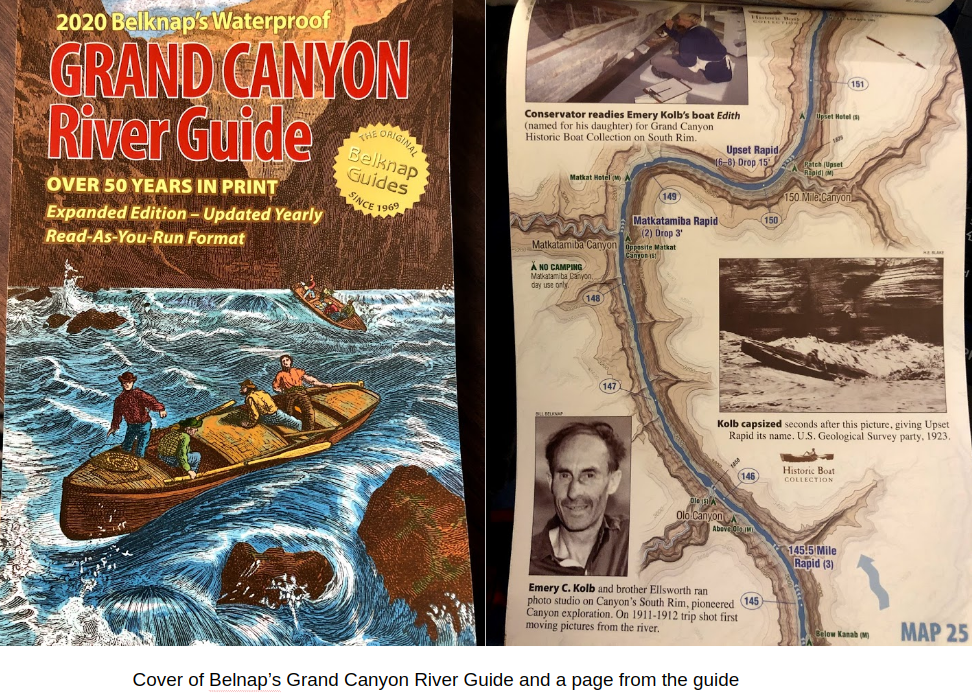
Geology of the Grand Canyon
As you can imagine, the geology of the Grand Canyon is a fascinating topic that many people have spent their entire careers studying. I knew next to nothing about the topic (despite having hiked the Bright Angel trail, a popular hiking trail in the Grand Canyon a few years ago), but learnt a fair amount from the guide book and listening to our trip guides. There are two points to understand. First, where did the rocks you see in the Grand Canyon come from, and second how was the Grand Canyon formed. To the second question, you may say, well the Colorado river carved and scoured out the Canyon over millions of years. The Colorado however isn’t the widest or the fastest flowing river in the world. Why didn’t far mightier rivers such as the Volga, Amazon or Brahmaputra carve out their own Grand Canyons?
Let’s go back to the first point – the origin of the rock layers around the Grand Canyon. Several times over the last billion years, the area around the Grand Canyon (called the Colorado plateau) was covered by ancient seas. Rivers and streams flowing into these seas brought sediments that accumulated and hardened into the strata that enclose the Grand Canyon. Most of the rocks you see around the Canyon were formed between 500 to 270 million years ago, nearly 70 million years before the Jurassic (age of the Dinosaurs). Think about this for a minute – the “newest” rocks around the Canyon (found near the rim) were formed nearly 200 million years before the asteroid impact that wiped out the dinosaurs and ushered in the age of the mammals!
What happened to the rocks that were formed later? They were simply eroded away. This tussle between erosion and deposition results in several “unconformities”, i.e., the absence of rock layers that can span several hundred million years. Rocks formed in a period when the rate of erosion is faster than the rate of deposition are eroded away, leaving no geological record. The picture below shows the “great unconformity” we saw at the Blacktail Canyon, one of the side canyons on day 4.
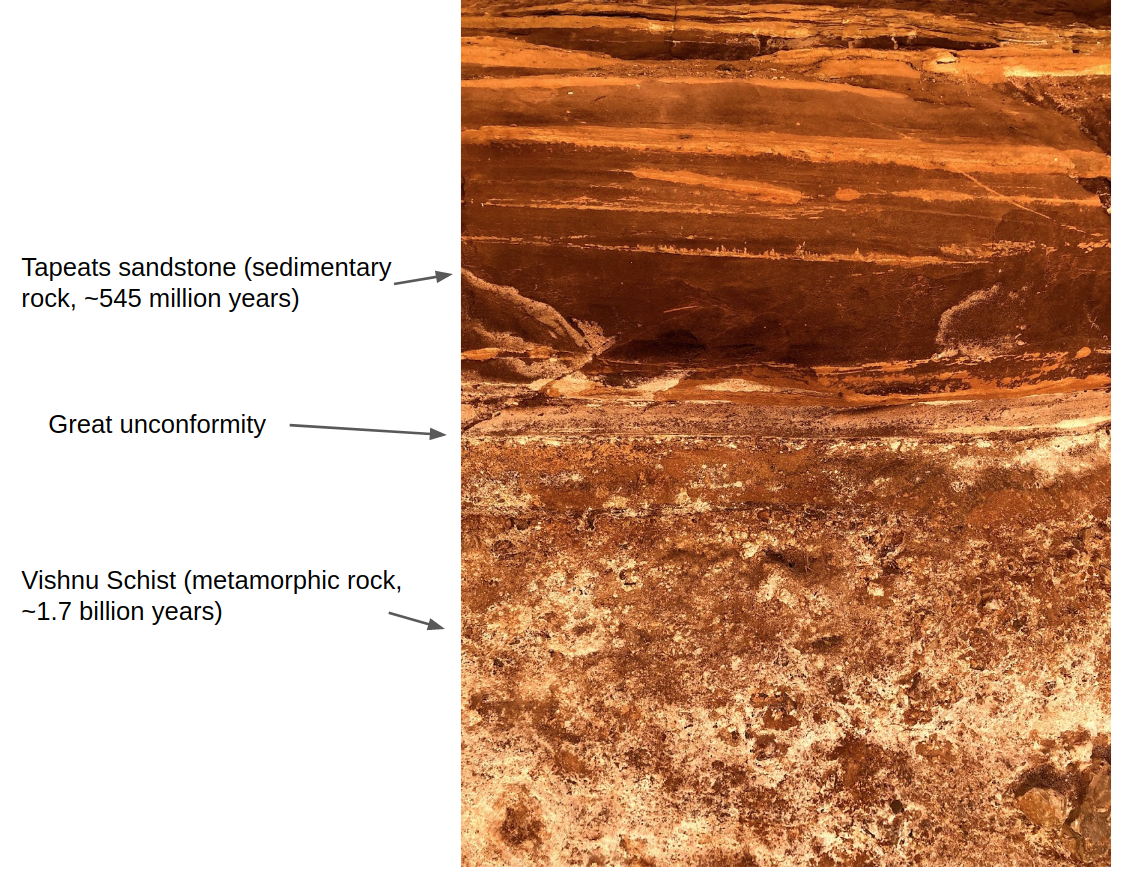
Traveling down the river deeper into the canyon is like a journey back in time. As you go deeper, older rock layers come into view, exposing another long bygone era in the history of the canyon. The rocks are teeming with fossils that reflect that environment that existed during the formation of the fossil. The oldest rocks (called the Vishnu schist, after the Hindu god Vishnu, considered to be the preserver of life according to Hindu mythology) are around 2 Billion years old, nearly half the age of the earth!
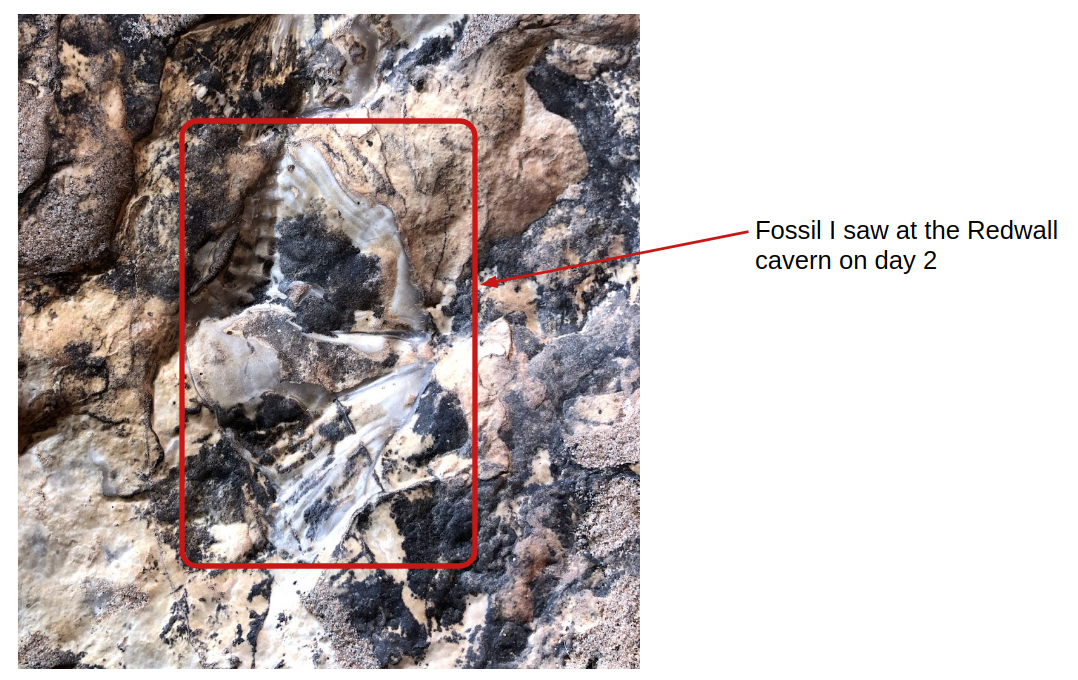
There are three main rock sequences in the stack of rocks you’ll see in the Grand Canyon (see picture below). The flat-lying strata that form the bulk of the canyon walls, an inclined set of strata below these and farther below, a completely different package of rocks that is metamorphic and igneous in origin. The first sequence is 545 to 270 million years old and consists of several horizontally stratified rocks. This sequence comprises the upper 80% of the walls of the Grand Canyon. These rock strata can have distinctive appearances and carry their own name. They reflect the ancient environments where they were formed, eg., Tapeats sandstone (wave-washed beaches), Redwall limestone (tropical seas teeming with marine life) and Coconino sandstone (vast Sahara-like deserts). The second sequence is between 1200 to 740 million years old and also consists of sedimentary rocks, however these rocks were subjected to faulting (vertical movement of one part of the crust relative to the other), which tilted the rock strata. Most of these rock layers have been eroded away so these are only visible in some places in the Canyon. The oldest rocks date back to the early to middle proterozoic era (1.8 – 1.6 billion years old, when most life on earth was still unicellular!) are called the Vishnu schist rocks. These rocks are metamorphic and igneous rocks. They were buried deep under the earth crust where they were chemically altered under immense heat and pressure. Thus, the Grand Canyon’s mile-high walls display a largely undisturbed cross section of the Earth’s crust extending back some two billion years!
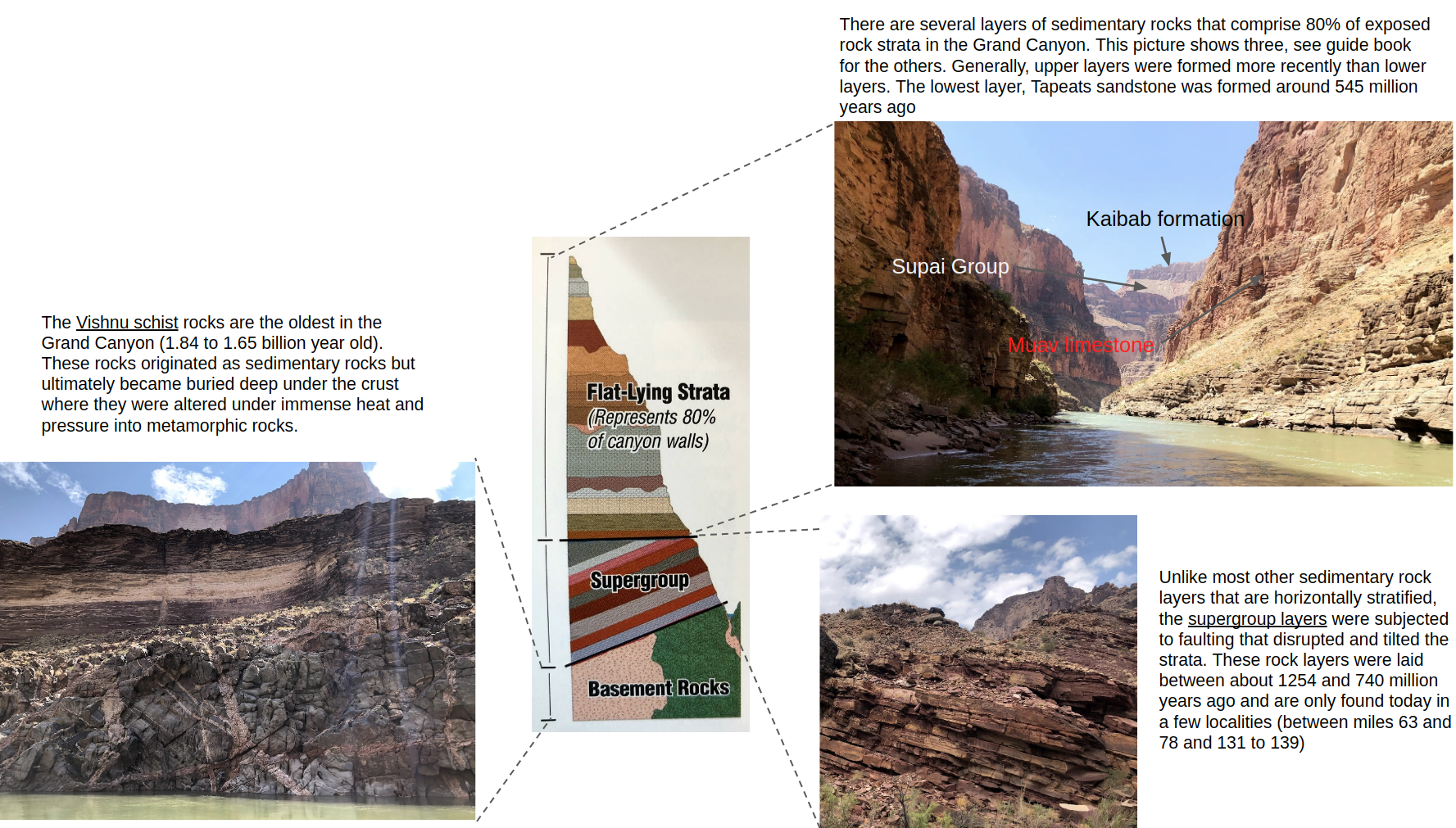
With this basic understanding of the rocks that form the Grand Canyon, let’s now turn to the second question – how was the Grand Canyon formed? Interestingly, while the rocks that form the Grand Canyon are many hundreds of million years old, the formation of the Canyon itself only began roughly 6 million years ago. Around 70 million years ago, the Colorado plateau began its rise above the sea level, subjecting to erosion layers of rock that had previously been underground. The last great ice age that began roughly 2.6 million years ago and ended about 11700 years ago resulted in large volumes of glacial meltwater from the Rockies, increasing the erosional power of the Colorado river. Finally, other geological processes lowered the land level to the west of the Grand Canyon, which steepened the gradient of the Colorado river, increasing flow rate and hence the cutting power of the river. Thus, multiple processes worked together to create the Grand Canyon.
Food and drinks
Our guides carried all of the food – meat, vegetables, bread etc., on the raft and cooked it every day. We had three meals everyday – breakfast, lunch and dinner. We also got some snacks (pretzels, M&Ms etc) throughout the day. There was abundant supply of water and lemonade available all day, on the raft and campsite. Our guides strongly encouraged us to stay hydrated.
Breakfast was served around 6 AM and consisted of coffee, eggs, bacon/pork chops/sausage and some type of sauce and orange juice. Around mid-day everyday, we would dock at a sandy area by the river and be served lunch, which was usually a very filling turkey/pork/beef sandwich with various spreads, bread choices and something sweet (like cookies) post lunch. Dinner was served around 7 after we docked into our campsite for that day. Dinner was a three course meal consisting of h’ordeuvres, main course and dessert. The first night we had steak, spinach and strawberry salad, asparagus, corn and brownies for dessert. For vegetarians, there was portobello mushroom dish. On day 3, we had chips, guacamole and salsa for h’ordeuvres and burritos, refried beans, chicken + peppers for dinner. On the final day, we had Salmon and cake for dessert. The food quality and complexity far exceeded my expectations. Some people on the trip reported eating better than they normally did!
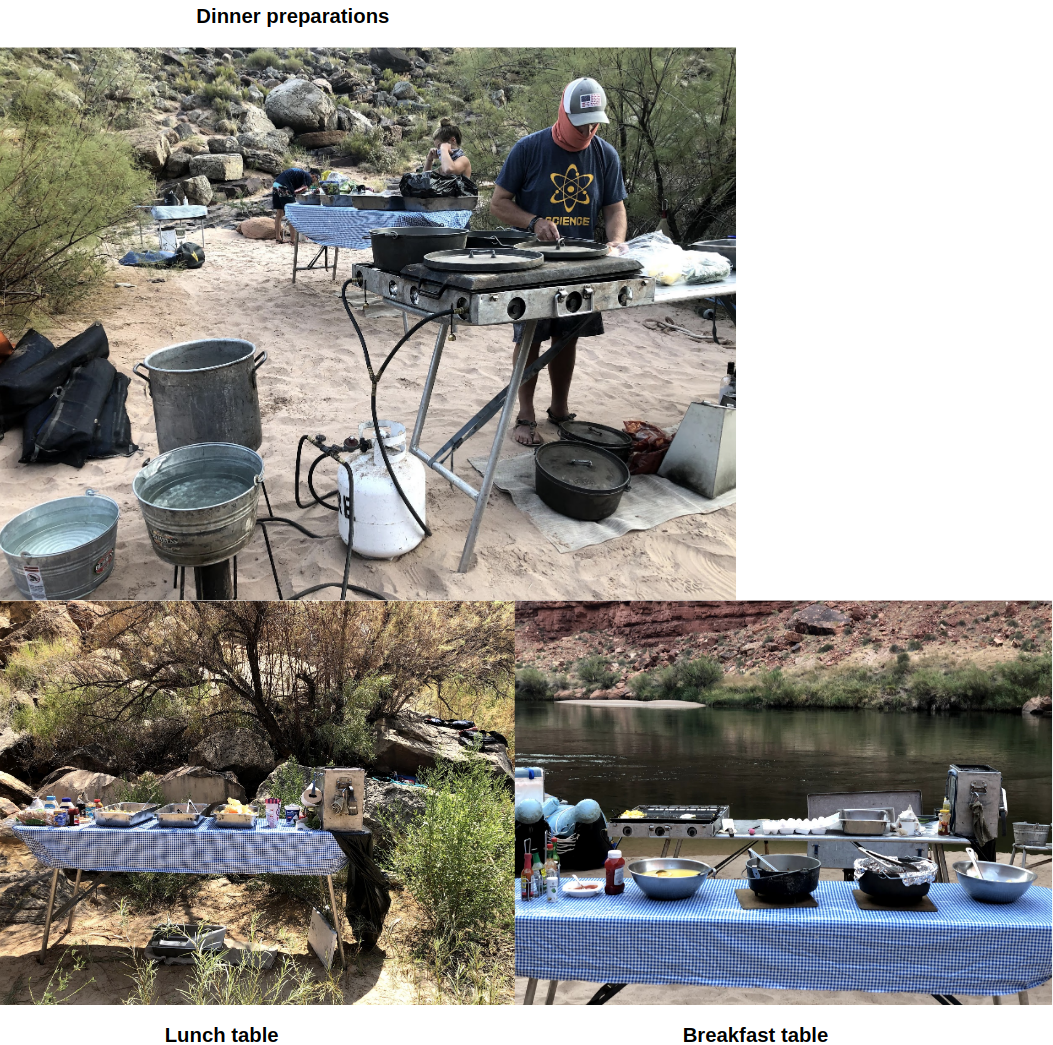
Sleeping
For sleeping, we were given collapsible cots. Most nights, I laid my sleeping bag (provided by the trip) on top of the cot and slept on the sleeping bag. Air temperature in the evening was very comfortable, and I had no problem falling asleep under the stars. Later in the night as temperature dropped, I had to pull up a sheet (provided along with our sleeping bags) on top. Some evenings we had a bit of rain and set up tents, but the rain never lasted more than a few minutes. We were also provided a tarp to cover our things in case it rained. The tarp came in handy on night 4 when it started raining just when I was about to fall asleep. Mike and I didn’t want to set up the tent so we just pulled the tarp on top of us. Thankfully the rain stopped after a a few minutes.
Every place we camped had an army of ants crawling on the ground. For some reason, these ants never crawled up our cots though. Thank god for that. One time I made the mistake of leaving an open protein bar in my rain suit. I spread out the rain suit to dry on a rock during the night. Next morning when I picked up the rain suit, I immediately felt several stings on my forearm. The rain suit was sprawling with ants! So, don’t leave any open food packets in your clothing (or anywhere) when you are camping!

Toilet and bathing
For toilet, portable toilets are carried on the rafts. The guides set these up at each campsite, a short walk from where people set up their tents. We used a disk (see below) to indicate that the toilet was in use. When done, whoever was using the toilet would return the disk back to the main campsite to indicate that the toilet was available for use. The guides also set up a station to wash hands.
For bathing, we just took a dip in the river water. The water temperature is cold (~50 F), so it takes a bit of courage to dip, but it felt great to apply some soap and shampoo and rinse off every evening after a long day in the sun and sand.
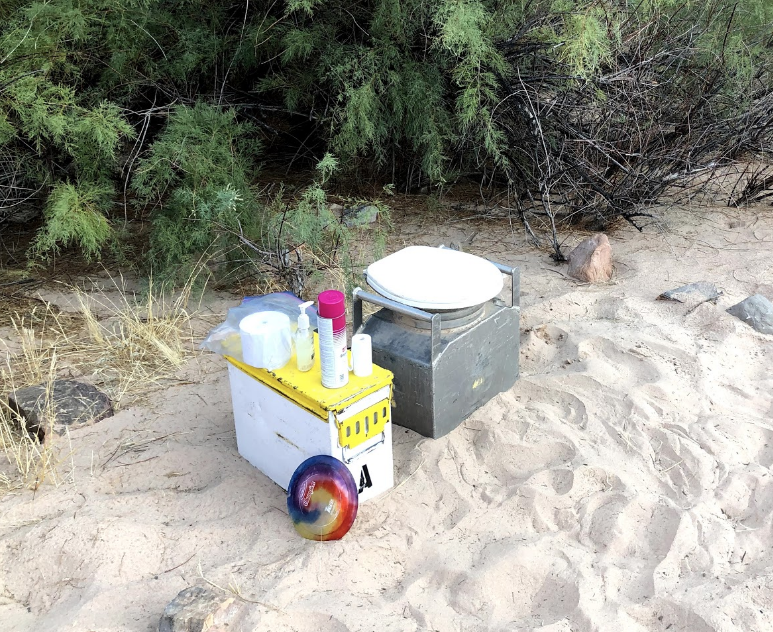
River Rapids
We went through scores of rapids along the river. Using the more familiar internationally accepted rapid rating system that ranks rapids from class 1 to class 6, most of the rapids along the Grand Canyon would be class 3 or 4. The Grand Canyon continues to use an older river rating scale that was developed before the International scale was introduced. A class 5 ( highly technical & difficult, etc.) on the international scale is equivalent to a 10 on the Grand Canyon scale. The big ones are Hermit, Crystal and Lava falls rapid. I almost fell off the raft while going through Hermit rapid, but was prevented from doing so by one of our guides who launched himself on top of me and we both held on. Even if I had fallen off, it wouldn’t have been that big of a deal, the river is wide and deep enough that there are very few entrapment spots where one can get pinned under a rock. Most rapids are just a sequence of big waves that crash down upon the raft as it passes through. Depending on your level of comfort with whitewater, physical fitness and sense of adventure, you can sit on the front of the raft where you face the full wrath of the rapids and must hold on tight to the ropes in front and behind you (this is where rugged gloves are helpful), or in the middle of the raft or along the sides, where you merely get splashed on and get a good laugh watching the people in the front get pummeled :-). I sat in the front through most of the rapids and had a blast (literally :-))
The water temperature is quite cold (~50 F) and repeatedly getting splashed with cold water can bring down your core temperature and cause shivering (happened to me numerous times). This is where the rain suit is very helpful, as it helps keep your inner clothing from getting soaked. Fortunately, the air temperature is warm (speaking from my experience in late August/early September), and it only takes a short while to warm up once you move away from the front of the raft to the middle, where you don’t get splashed as much.
Another wonderful warming factor was this delightful, warm wind that often blew across the surface of the water and slowed down and picked up pace seemingly at random. At times, the wind was so strong that it lifted up water from the surface of the river and sprayed it on us. In the mid afternoon with the sun beating directly down on us, being sprayed with cool droplets of water was quite delightful!
In the rest of the post, I’ll describe the sights and sounds I experienced over the 6 days of rafting on the Canyon.
Day 1
On day 1, we boarded our rafts near Lees Ferry. We were given two bags (dry bags where you take the air out, roll down the top and then bring the two halves of the buckle around and clip them together) – a smaller one in which we stored items for day use such as sun screen, granola bars and camera; and a larger one that already contained a sleeping bag and tarp and where we put the rest of our belongings. We had access to the day bag during the day. The bigger bag was put in storage on the raft and handed back to us when we set up camp. We would do this for the remainder of the trip – separate what we needed during the day from the rest of our stuff and put it in the day bag.
We floated downstream for a few miles and our guide gave us interesting info about the rock layers that were starting to emerge and stories of the various explorers who had attempted to journey down the Grand Canyon. We stopped in a shady spot with a rock overhang ahead to exchange names and general info of the other people on board the raft and a short while later for lunch. Around 4PM we docked the raft and set up camp at the North Canyon camp around mile 20, one of the many campsites along the Grand Canyon.
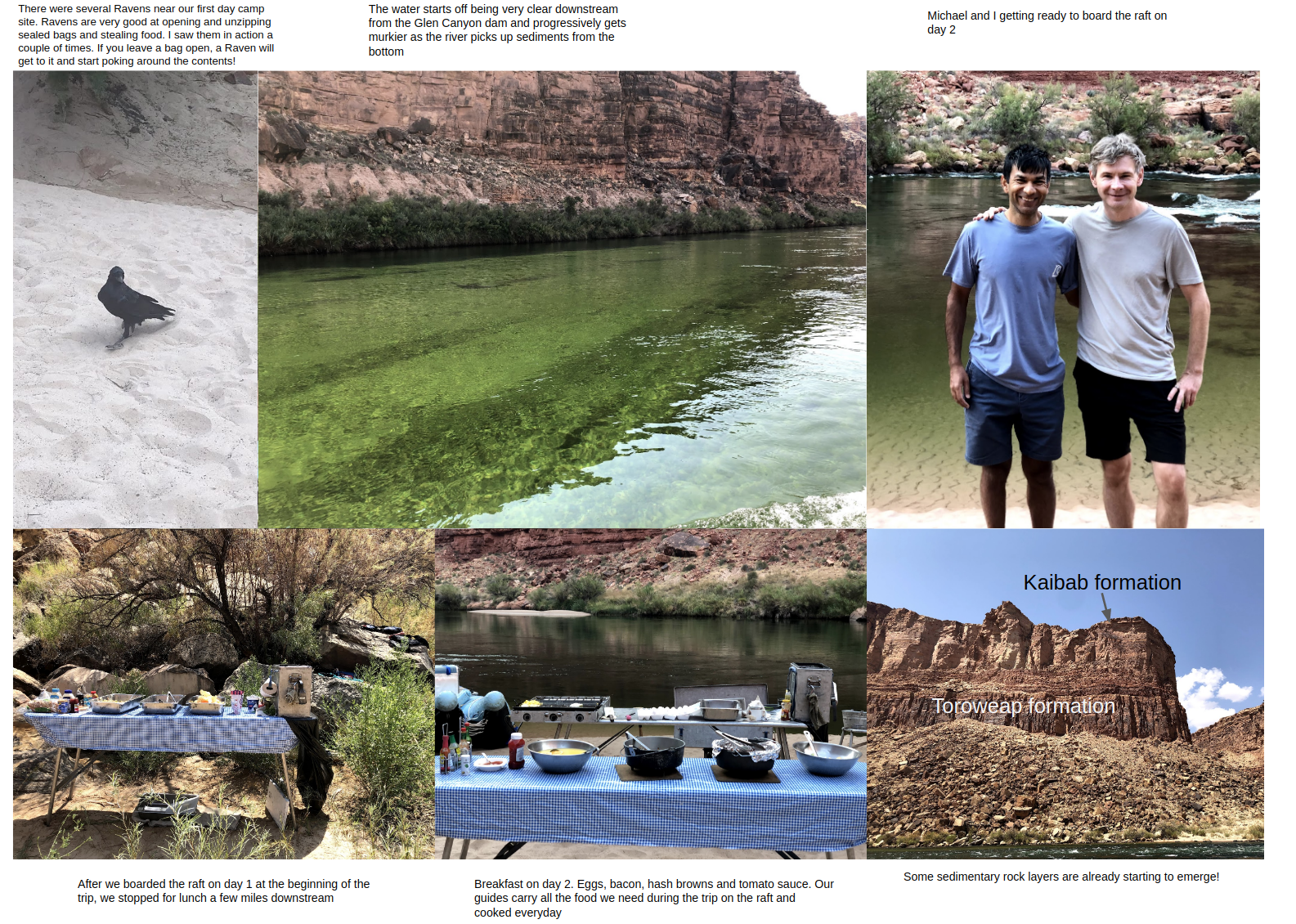
Day 2:
Highlight of day 2 was visiting the Redwall Cavern, a vast chamber carved by the river which is also where we had lunch. We also ran into some people on “human motored” smaller rafts and boats that needed to be paddled. I felt a twinge of guilt sitting nice and comfortable on our motorized raft as we passed by the paddlers. According to our guide, it takes the paddlers about twice as long to cover the same distance. Here’s a company that organizes paddle raft trips.
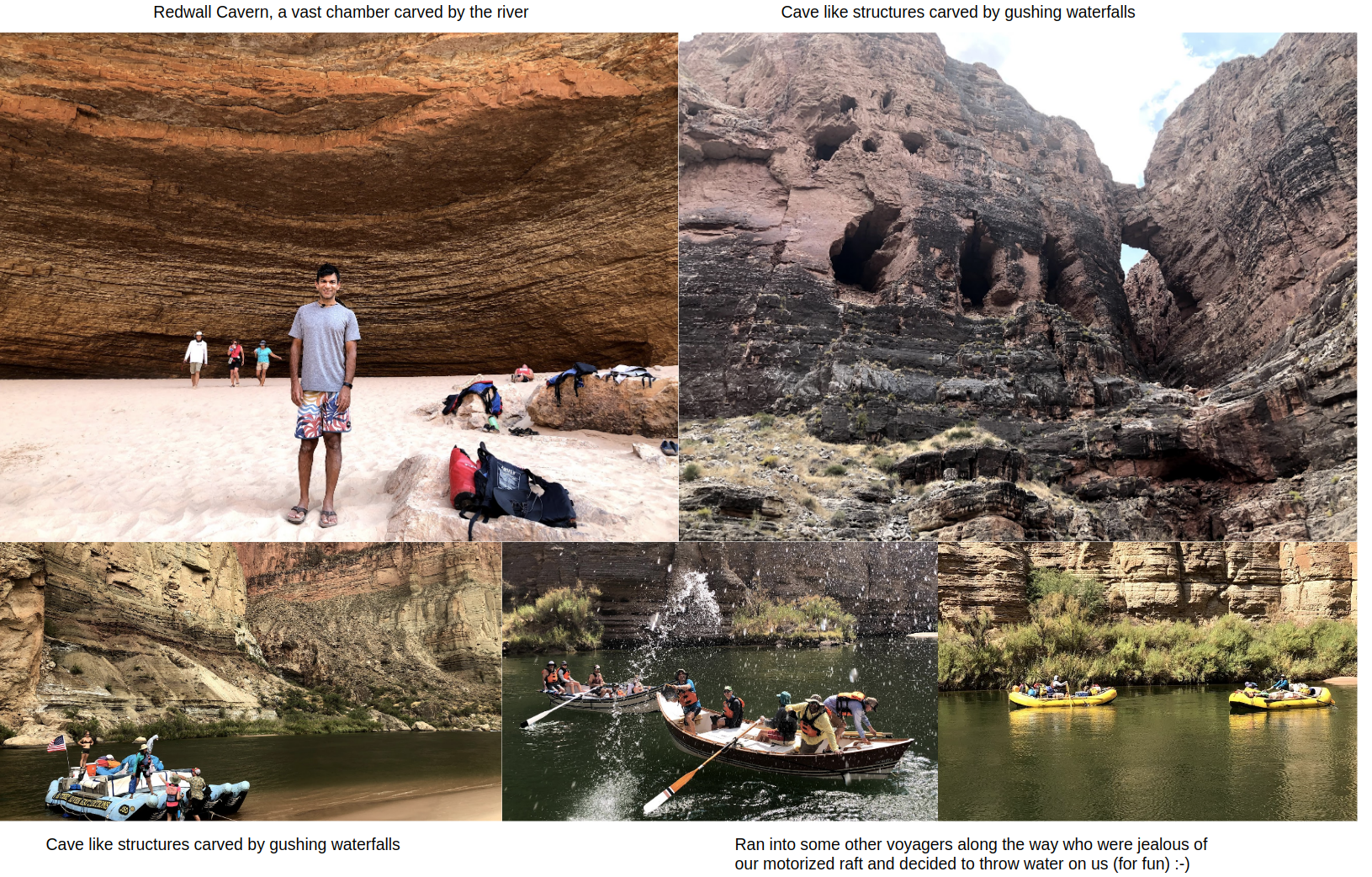
We were scheduled to camp at a site from where we could hike over to see the pueblo granaries, however the campsite was already taken. The granaries look like a row of square windows cut into the sandstone around A.D. 1100 by ancestral Pueblos. They used the granaries as storage units to store grain such as pumpkin seeds and corn from the river delta below. The granaries helped keep the food dry during floods and protected it against rodents and other creatures.
I was a bit disappointed, but perhaps that’s one reason to do another Grand Canyon trip! Here’s a highly zoomed in picture of the granaries that I took from the raft as we were passing the site.
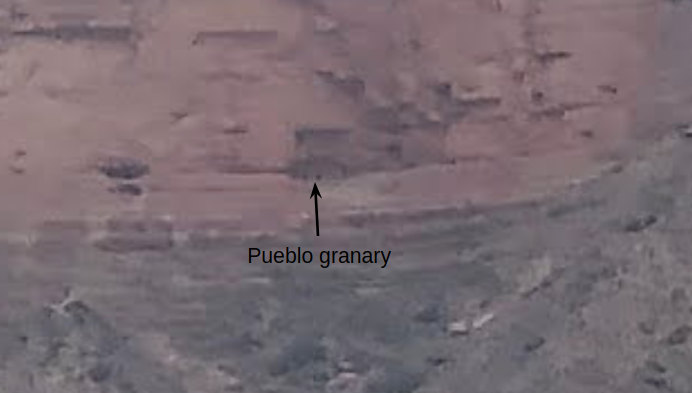
Day 3:
The highlight of Day 3 was without question a short hike down the banks of the little Colorado river (mile 62, see map below). The little colorado is one of the major tributaries of the Colorado river. The river water is normally a bright blue color caused by dissolved limestone in the water. The limestone concentration is so high that the rocks around the river are covered by a thin layer of powdery white limestone (Calcium Carbonate). We had fun doing short “butt down, legs up” floats down the river.
During our float down the river on day 3, all major rock formations – the flat lying strata, super group rocks and Vishnu schist and zoroaster granite (first appear around mile 77) had all made their appearance. With their undifferentiated, irregular structure and black color, the Vishnu schist rocks are strikingly different in appearance from the other two rock groups. It is also sobering to think that these rocks were formed miles under the earth crust under immense temperature and pressure and are now exposed for us to see by the Colorado river.
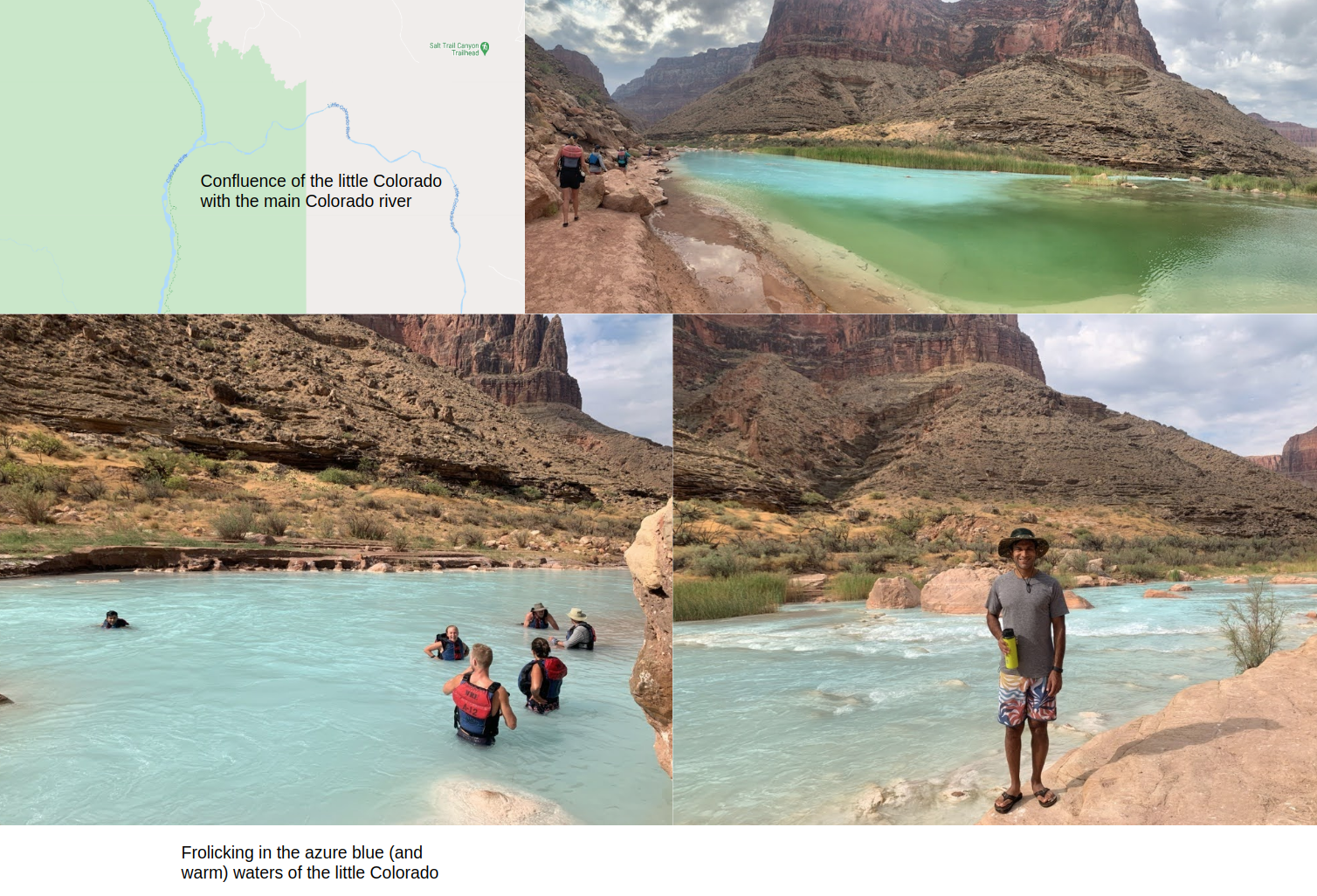
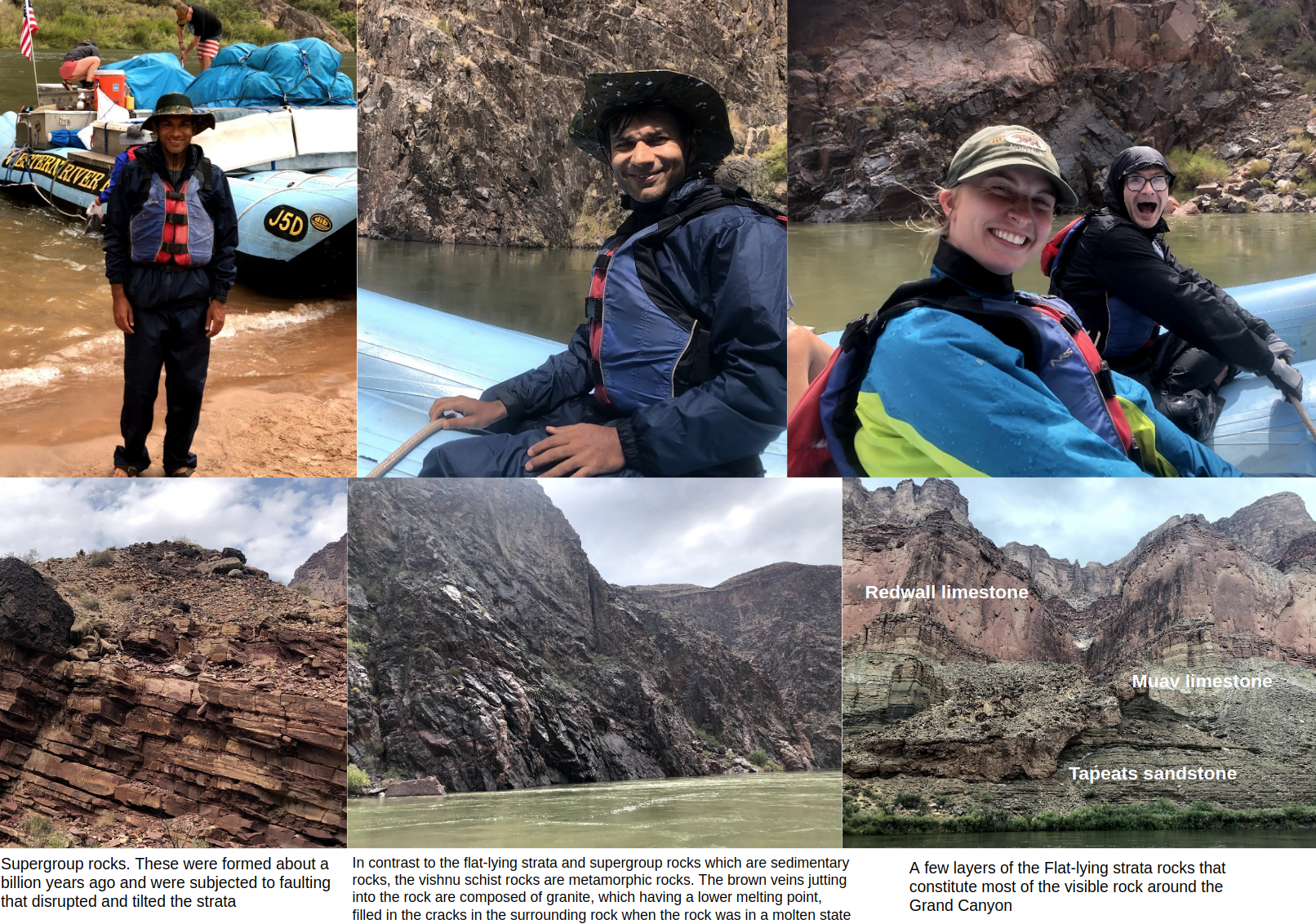
Day 4
Day 4 was mostly cruising down the river and taking in the sights. We did a short hike to a waterfall and I along with some people on the trip did a self-guided hike plus rock scramble around lunch time. After dinner, our tour guide brought out his guitar and we had a very enjoyable evening singing some classic rock favorites. I tried my hand at the guitar also, and was quite disappointed by how my guitar skills have atrophied. Need to order a guitar and start practicing!
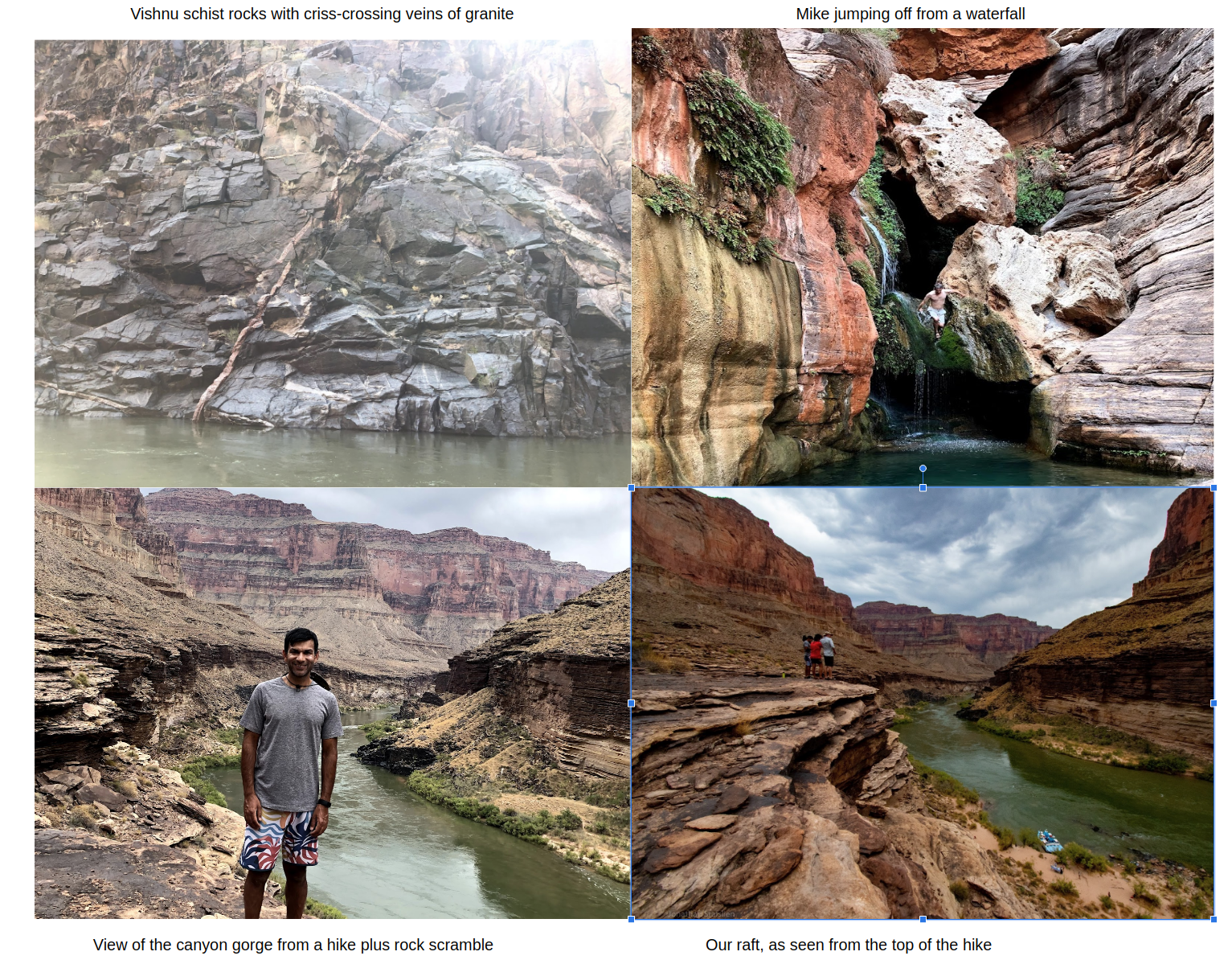
Day 5
Highlight of day 5 was a visit to Deer Creek falls near mile 137 followed by a hike up and along the Deer Creek canyon. Walking along the top of the gorge and looking down into the sinuous, nearly vertical walls of the canyon at the creek gushing at the bottom was a mesmerizing and almost spiritual experience. Given enough time, flowing water will eat through the toughest rock! We were also supposed to visit the renowned Havasu canyon, but didn’t have permission to do so. The area around Havasu canyon is tribal land and the tribal authorities had restricted tourist visitation due to Covid-19 concerns.
The evening was relatively cloudless and after sun down, we witnessed a gorgeous view of a nearly full moon sweeping the canyon walls with light as it moved across the sky. Living in the city, it is easy to forget that moonlight is a real thing. Down in the Canyon valley, far away from city lights, it was possible to walk around in the middle of the night guided only by moonlight, no flashlight needed. The star studded sky put on a great show was well.
This being our last evening, our guides cooked a special dinner for us, consisting of Salmon, Green Beans and Cake. Some of us stayed up late drinking wine and recounting stories (and gossiping about people on the trip 🙂 ).
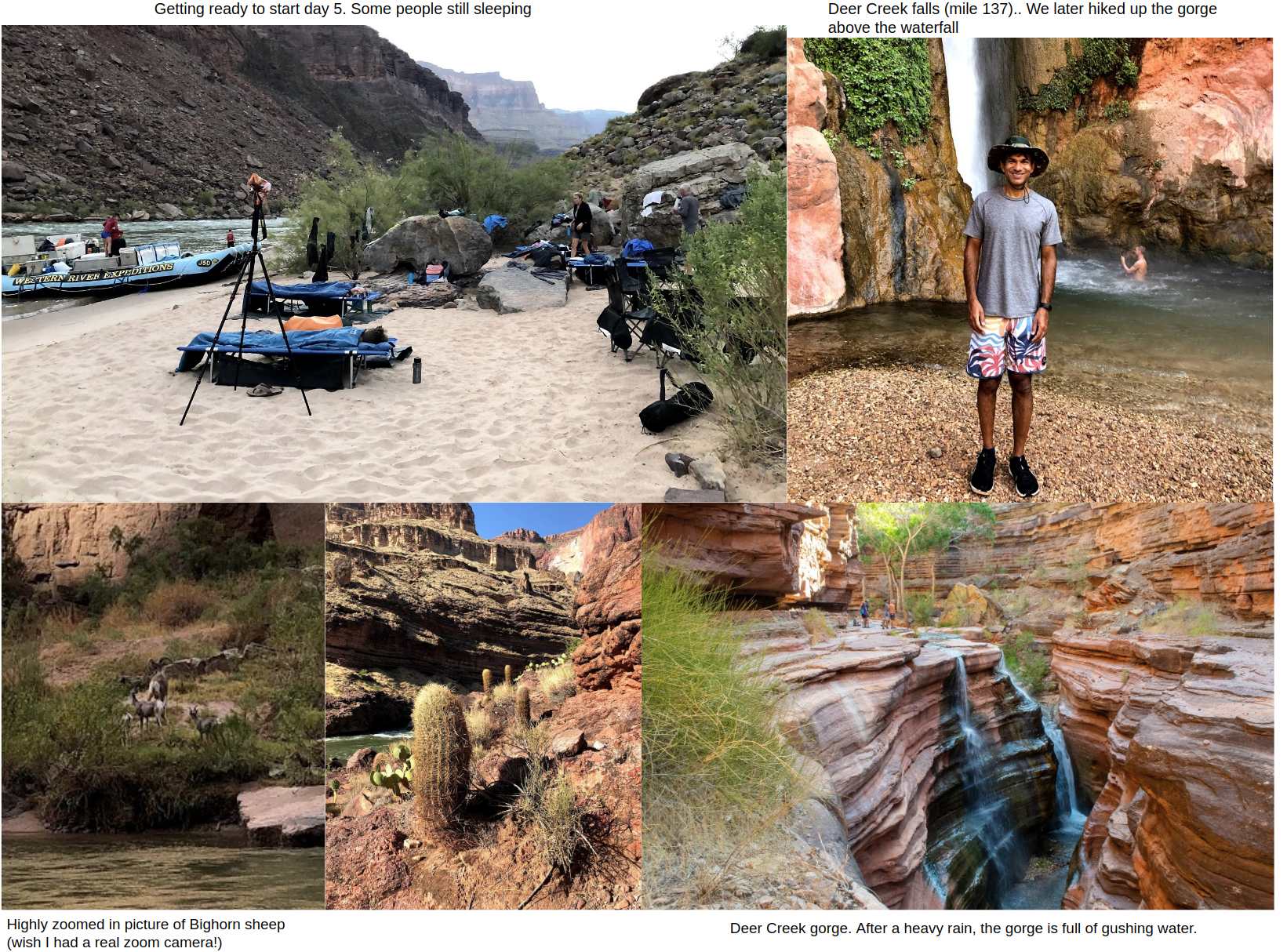
Day 6
Day 6 was our last day on the river. We handed in our dinner plates and utensils (which were provided to us at the beginning of the trip) and floated down the river to Whitmore wash, our helicopter pick area. Along the way, we ran Lava falls, one of the biggest rapids on the river. Although after running it, most people on the boat agreed that we had been through far worse. Lava falls bears its name from the volcanic basalt lava rocks visible in this part of the canyon. Hundreds of volcanic eruptions occurred over the past two million years, which is like yesterday on a geological timescale. At least a dozen times, lava cascaded down the walls of the gorge, forming massive lava dams that blocked the flow of the Colorado River. Three of these lava dams were over 1,000 feet high, forming lakes similar to reservoirs such as Lake Powell or Lake Mead. Some of the lakes were over 100 miles long and filled the lower portion of the Grand Canyon for many years before finally over-topping the dam and eroding much of it away. Not much evidence remains of the dams, but the black, amorphous lava flows and volcanic rocks could be seen clearly against the backdrop of the stratified, multi-colored typical canyon rocks.
Shortly before hitting lava falls rapids, each person in our group recounted their highs and lows of the trip. Some of the stories were quite touching; specially those who had recently lost loved ones due to Covid and were looking to reset.
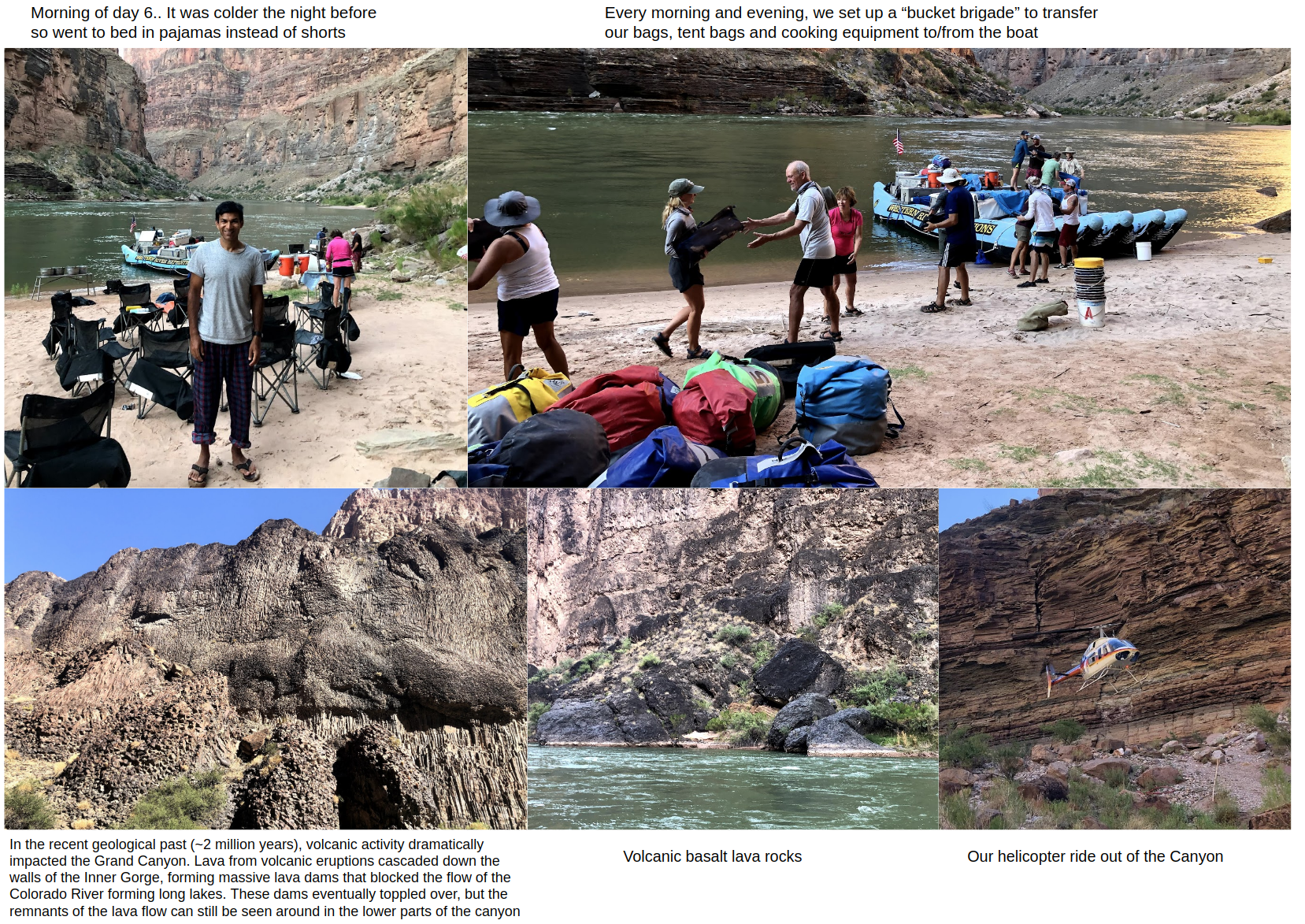
The helicopter dropped us off at the Bar Ten ranch, where we got to take a real shower after many days. A small plane brought us back to the Boulder City Municipal Airport from where we took a bus ride back to Las Vegas. Thus ended a glorious and unforgettable trip reconnecting with mother nature and being reminded of the beauty and wonder of this third rock from the sun we are so lucky to call home; the likes of which there is nothing else in the universe that we know of; and whose delicate and fragile ecosystem we must do everything to protect and preserve.

Excellent effort , described all the details very minutely with nice pics. These details May be of immense Benefit to your operators for marketing
Thank you Ankur for an excellent description of the trip!
Definitely on the bucket list now.
Ankur, this is an amazing and detailed recounting of our magical trip. Thank you for your excellent company during this unforgettable time.
Thanks Zenia, it was so good meeting you on the trip!